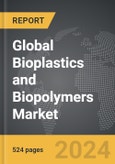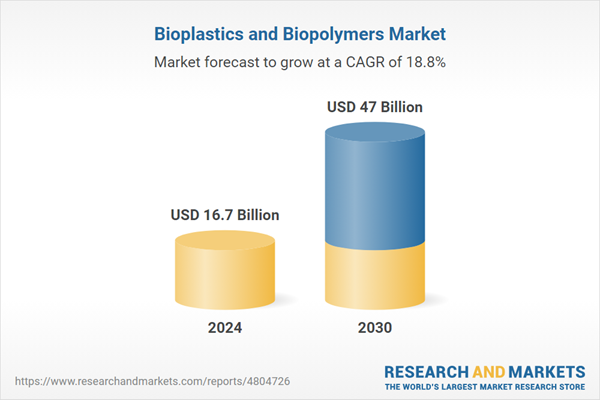Global Bioplastics and Biopolymers Market - Key Trends & Drivers Summarized
What Innovations Are Shaping the Future of Bioplastics and Biopolymers?
The bioplastics and biopolymers market has been undergoing significant advancements, driven by the demand for sustainable alternatives to conventional petroleum-based plastics. Bioplastics are derived from renewable sources like corn starch, sugarcane, and cellulose, while biopolymers are natural polymers produced by the cells of living organisms. Recent innovations include the development of biodegradable plastics, which can break down under specific environmental conditions, addressing global concerns about plastic waste and pollution. Furthermore, biopolymers such as polylactic acid (PLA) and polyhydroxyalkanoates (PHA) are gaining traction due to their eco-friendly properties and ability to decompose more quickly than traditional plastics. As industries continue to prioritize sustainability, advancements in material science are leading to the creation of more durable, versatile, and cost-effective bioplastic solutions, positioning them as key players in the global push for a circular economy.How Are Industry Applications Transforming the Demand for Bioplastics and Biopolymers?
The demand for bioplastics and biopolymers is rapidly expanding across various industries, with applications ranging from packaging and agriculture to automotive and consumer goods. The packaging industry, in particular, has become one of the largest consumers of bioplastics, as companies and brands are seeking eco-friendly materials to replace traditional plastics. Compostable packaging materials, such as biopolymer-based films and containers, are becoming increasingly popular in the food and beverage industry, where reducing waste and complying with sustainability regulations are top priorities. In agriculture, biodegradable mulch films made from biopolymers are helping to reduce the environmental footprint of farming practices. Similarly, in the automotive sector, manufacturers are incorporating bioplastic components into vehicle interiors to meet the growing demand for greener vehicles. The versatility of bioplastics and biopolymers, coupled with their ability to meet industry-specific needs, is transforming their role across multiple markets.How Is Consumer Awareness and Regulation Influencing the Bioplastics Market?
Consumer behavior is playing a pivotal role in the growing adoption of bioplastics and biopolymers. With increasing awareness of environmental issues, consumers are demanding more sustainable products, driving brands and manufacturers to shift towards eco-friendly materials. This shift is particularly evident in sectors like packaging, where sustainability certifications and labeling for bioplastic products are becoming essential for brands looking to meet consumer expectations. Additionally, government regulations aimed at reducing plastic waste and promoting the use of biodegradable materials are shaping market dynamics. The European Union's Single-Use Plastics Directive and similar legislation in other regions are pushing companies to transition away from traditional plastics and adopt bioplastics. As governments continue to implement stricter environmental policies, the role of bioplastics in mitigating plastic pollution is becoming more prominent, further influencing consumer choices and corporate strategies.What Are the Key Growth Drivers in the Bioplastics and Biopolymers Market?
The growth in the bioplastics and biopolymers market is driven by several factors that are reshaping the industry landscape. Technological advancements in polymer science have enabled the development of more cost-effective and efficient bioplastic solutions, improving their performance and expanding their use across industries. The rising demand for sustainable and biodegradable materials, particularly in the packaging, automotive, and agricultural sectors, is a key driver of market growth. Additionally, stringent environmental regulations in various regions are pushing industries to reduce their reliance on petroleum-based plastics, further fueling the adoption of biopolymers. Consumer awareness of plastic pollution and the desire for eco-friendly products have also accelerated the market's expansion. Lastly, the shift towards circular economy models, where the focus is on reducing waste and reusing materials, is creating new opportunities for bioplastics and biopolymers, positioning them as critical components in achieving global sustainability goals.Report Scope
The report analyzes the Bioplastics and Biopolymers market, presented in terms of market value (USD). The analysis covers the key segments and geographic regions outlined below.- Segments: Type (Non-Biodegradable Bioplastics & Biopolymers, Biodegradable Bioplastics & Biopolymers); Application (Packaging Application, Consumer Goods Application, Textiles Application, Automotive & Transportation Application, Other Applications).
- Geographic Regions/Countries: World; USA; Canada; Japan; China; Europe; France; Germany; Italy; UK; Rest of Europe; Asia-Pacific; Rest of World.
Key Insights:
- Market Growth: Understand the significant growth trajectory of the Non-Biodegradable Bioplastics & Biopolymers segment, which is expected to reach US$22.2 Billion by 2030 with a CAGR of 17.4%. The Biodegradable Bioplastics & Biopolymers segment is also set to grow at 20.3% CAGR over the analysis period.
- Regional Analysis: Gain insights into the U.S. market, valued at $3.8 Billion in 2024, and China, forecasted to grow at an impressive 22.2% CAGR to reach $5.4 Billion by 2030. Discover growth trends in other key regions, including Japan, Canada, Germany, and the Asia-Pacific.
Why You Should Buy This Report:
- Detailed Market Analysis: Access a thorough analysis of the Global Bioplastics and Biopolymers Market, covering all major geographic regions and market segments.
- Competitive Insights: Get an overview of the competitive landscape, including the market presence of major players across different geographies.
- Future Trends and Drivers: Understand the key trends and drivers shaping the future of the Global Bioplastics and Biopolymers Market.
- Actionable Insights: Benefit from actionable insights that can help you identify new revenue opportunities and make strategic business decisions.
Key Questions Answered:
- How is the Global Bioplastics and Biopolymers Market expected to evolve by 2030?
- What are the main drivers and restraints affecting the market?
- Which market segments will grow the most over the forecast period?
- How will market shares for different regions and segments change by 2030?
- Who are the leading players in the market, and what are their prospects?
Report Features:
- Comprehensive Market Data: Independent analysis of annual sales and market forecasts in US$ Million from 2024 to 2030.
- In-Depth Regional Analysis: Detailed insights into key markets, including the U.S., China, Japan, Canada, Europe, Asia-Pacific, Latin America, Middle East, and Africa.
- Company Profiles: Coverage of players such as 2D Chemical Ltd., ABM Composite, ADBioplastics, Advance Bio Material P. Ltd., Agrana Beteiligungs-AG and more.
- Complimentary Updates: Receive free report updates for one year to keep you informed of the latest market developments.
Some of the 114 companies featured in this Bioplastics and Biopolymers market report include:
- 2D Chemical Ltd.
- ABM Composite
- ADBioplastics
- Advance Bio Material P. Ltd.
- Agrana Beteiligungs-AG
- Akro-Plastic GmbH
- Archer-Daniels-Midland Company
- Arkema Group
- Ataman Kimya A.S.
- Avantium NV
This edition integrates the latest global trade and economic shifts into comprehensive market analysis. Key updates include:
- Tariff and Trade Impact: Insights into global tariff negotiations across 180+ countries, with analysis of supply chain turbulence, sourcing disruptions, and geographic realignment. Special focus on 2025 as a pivotal year for trade tensions, including updated perspectives on the Trump-era tariffs.
- Adjusted Forecasts and Analytics: Revised global and regional market forecasts through 2030, incorporating tariff effects, economic uncertainty, and structural changes in globalization. Includes historical analysis from 2015 to 2023.
- Strategic Market Dynamics: Evaluation of revised market prospects, regional outlooks, and key economic indicators such as population and urbanization trends.
- Innovation & Technology Trends: Latest developments in product and process innovation, emerging technologies, and key industry drivers shaping the competitive landscape.
- Competitive Intelligence: Updated global market share estimates for 2025, competitive positioning of major players (Strong/Active/Niche/Trivial), and refined focus on leading global brands and core players.
- Expert Insight & Commentary: Strategic analysis from economists, trade experts, and domain specialists to contextualize market shifts and identify emerging opportunities.
Table of Contents
Companies Mentioned (Partial List)
A selection of companies mentioned in this report includes, but is not limited to:
- 2D Chemical Ltd.
- ABM Composite
- ADBioplastics
- Advance Bio Material P. Ltd.
- Agrana Beteiligungs-AG
- Akro-Plastic GmbH
- Archer-Daniels-Midland Company
- Arkema Group
- Ataman Kimya A.S.
- Avantium NV
Table Information
| Report Attribute | Details |
|---|---|
| No. of Pages | 452 |
| Published | December 2025 |
| Forecast Period | 2024 - 2030 |
| Estimated Market Value ( USD | $ 16.7 Billion |
| Forecasted Market Value ( USD | $ 47 Billion |
| Compound Annual Growth Rate | 18.8% |
| Regions Covered | Global |









